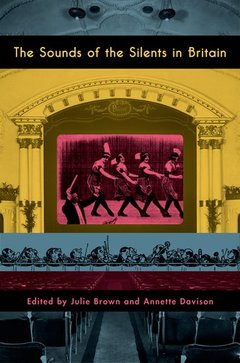Description
The Sounds of the Silents in Britain
Coordinators: Brown Julie, Davison Annette
Language: English
Publication date: 12-2012
Support: Print on demand
Support: Print on demand
Description
/li>Biography
/li>
The Sounds of the Silents in Britain explores the sonic dimension of film exhibition in Britain, from the emergence of cinema through to the introduction of synchronized sound. Edited by Julie Brown and Annette Davison, the volume includes original scholarship from many highly-regarded experts on British silent film from a range of disciplinary backgrounds, such as film history, theatre studies, economic history, and musicology. The essays provide an introduction to diverse aspects of early film sound: vocal performance, from lecturing and reciting, to voicing the drama; music, from the forerunners of music for visual spectacle to the impact of legislation and the development of film music practice; and performance in cinemas more generally, from dancing and singalong films, to live stage prologues, and even musical performances captured in British Pathé's early sound shorts. Other topics include the sonic eclecticism of performances at the Film Society, British International Pictures' first synchronized sound films, and the role of institutions such as the Musicians' Union and the Performing Right Society in relation to cinema music and musicians. In addition to tackling these familiar topics from surprising new angles, The Sounds of the Silents in Britain also debunks some of the myths about the sonic dimension of film exhibition. For example, the book reveals that local venue licensing decisions had a profound effect on whether music could even be performed with film in some British performances spaces and cities, and that the same was true of live acts alongside film - even into the late 1920s. The books also bring to light the fact that, in terms of special film presentation and orchestral accompaniment, practices in London were arguably more sophisticated than those in New York before the onset of World War I; that lecturing to film in Aberdeen, Scotland had almost as long a life as Japanese benshi; and that the London Film Society was as eclectic in its approach to sound as it was in programming the films themselves. Filled with both archival research and sound musicological analysis, The Sounds of the Silents in Britain represents an important addition to early film and film music scholarship.
Julie Brown is Reader in Music at Royal Holloway, University of London. She has written on early twentieth-century music (especially Schoenberg and Bartók), television music and film music. Her publications include Bartók and the Grotesque: Studies in Modernity, the Body and Contradiction in Music, and Western Music and Race, which was awarded the American Musicological Society's Ruth A. Solie Award. Annette Davison is Senior Lecturer in Music at the University of Edinburgh. Her research focuses on film music and sound, music for the stage and for television. Publications include Hollywood Theory, Non-Hollywood Practice: Cinema Soundtracks in the 1980s and 1990s (2004), Alex North's A Streetcar Named Desire: A Film Score Guide (2009), and, with Erica Sheen, American Dreams, Nightmare Visions: The Cinema of David Lynch (2004).
© 2024 LAVOISIER S.A.S.




